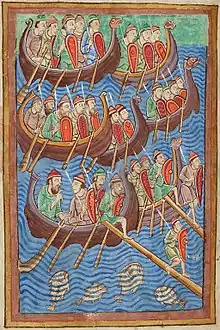Julian D. Richards
Julian Daryl Richards is a British archaeologist. He works at the University of York, and the Archaeology Data Service (ADS),[1] and is the editor of Internet Archaeology.[2] He is also the director of the Centre for Digital Heritage at the university, and contributed to the founding of The White Rose College of the Arts & Humanities.[1] His work focuses on the archaeological applications of information technology. He has participated in excavations at Cottam, Cowlam, Burdale, Wharram Percy, and Heath Wood barrow cemetery.[1]
Career

Richards studied archaeology and anthropology at the University of Cambridge, after switching from history. He began his Ph.D. in 1980, researching burial rituals among pre-Christian Anglo-Saxons. In the 1970s or 1980s Richards was a volunteer in the excavations of Viking Age settlements around the Coppergate Shopping Centre in York. He then spent time at the University of Leeds, before returning to York in 1986 to lecture about Anglo-Saxon and Viking archaeology at the University of York.[1]
Richards lectured at the University of York, concentrating on Anglo-Saxon and Viking Age archaeology, particularly mortuary behaviour and settlement evolution, in England. In that capacity he published Viking Age England in 1991,[3] and has worked at Cottam, Cowlam, Burdale, Wharram Percy, and Heath Wood barrow cemetery. As of February 2018, he is re-examining a winter camp used by the Great Viking Army at Torksey, Lincolnshire,[1][4][5] stretching over 136 acres (55 ha).[6][7]
Another concentration of Richards is the intersection of archaeology and technology. In 1985 he co-edited a textbook on archaeological computing, Current Issues in Archaeological Computing,[8] a focus of subsequent books and papers.[1] He is the director of the Archaeology Data Service, a digital archive of archaeological research,[1] and the co-director of Internet Archaeology, an electronic peer-reviewed journal.[2] He is also the director the Centre for Digital Heritage at the University of York.
Publications
- Richards, Julian D. (1992). "Anglo Saxon Symbolism". In Carver, Martin (ed.). The Age of Sutton Hoo: The seventh century in north-western Europe. Woodbridge: Boydell Press. pp. 131–147.
- Richards, Julian D.; Hadley, Dawn M. (2016). "The Viking Winter Camp and Anglo-Scandinavian Town at Torksey, Lincolnshire – The Landscape Context". In Turner, Val E.; Owen, Olwyn A.; Waugh, Doreen J. (eds.). Shetland and the Viking World: Papers from the Seventeenth Viking Congress, Lerwick. Lerwick: Shetland Amenities Trust. pp. 127–139. ISBN 978-0-9932740-3-9.
- Hadley, Dawn M.; Richards, Julian D. (September 2016). "The Winter Camp of the Viking Great Army, AD 872–3, Torksey, Lincolnshire" (PDF). The Antiquaries Journal. Society of Antiquaries of London. 96: 23–67. doi:10.1017/s0003581516000718.

References
Bibliography
- "About Us". Internet Archaeology. Retrieved 13 June 2017.

- Batey, Colleen (1992). "Review: Viking Age England". The Archaeological Journal. British Archaeological Institute. 149 (1): 433–434. doi:10.1080/00665983.1992.11078027.

- "Julian D Richards, Professor of Archaeology". Department of Archaeology. University of York. Retrieved 13 June 2017.

- Nixon, Joseph M. (November 1987). "Review: Current Issues in Archaeological Computing". Plains Anthropologist. Plains Anthropological Society. 32 (118): 435–437. JSTOR 25668724.

- Pappas, Stephanie (25 May 2017). "Vikings Wintered and Planned Raids at 9th-Century English Site". Live Science. Retrieved 6 May 2018.

- "Viking Army Camp Uncovered by Archaeologists in England". ScienceDaily. 18 May 2017. Retrieved 6 May 2018.

- Weiss, Daniel (March–April 2018). "The Viking Great Army: A Tale of Conflict and Adaptation Played Out in Northern England". Archaeology. Archaeological Institute of America. ISSN 0003-8113. Retrieved 6 May 2018.
